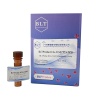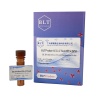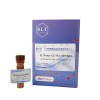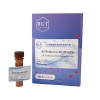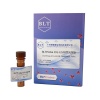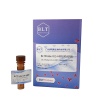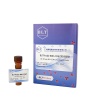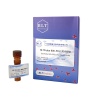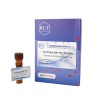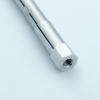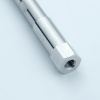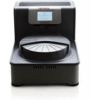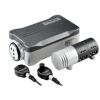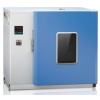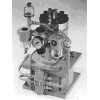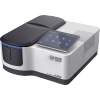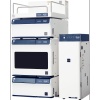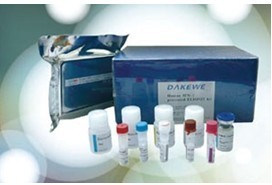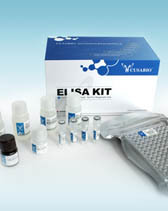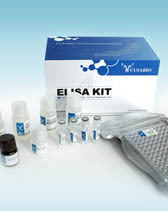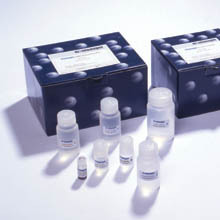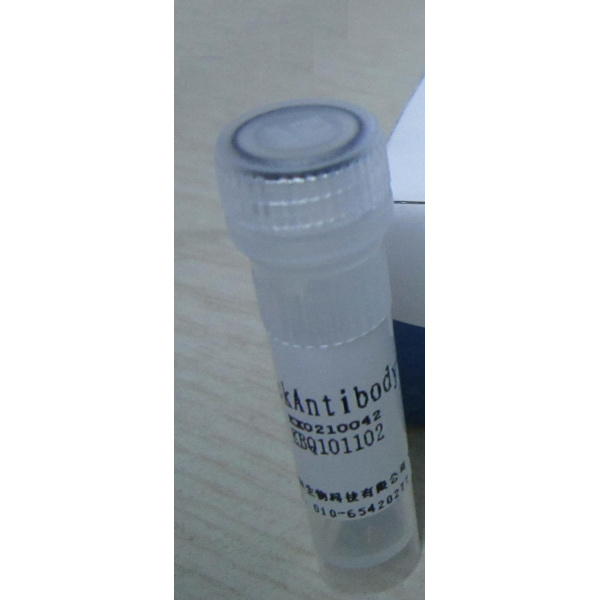


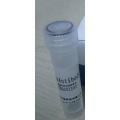
英文名称 EV71 polyprotein VP4
中文名称 肠道病毒71型/手足口病病毒抗体
别 名 EV71; Enterovirus 71; VP4 [Human enterovirus 71]; polyprotein; VP4 capsid protein; capsid protein; polyprotein VP0.
说 明 书 0.1ml 0.2ml 1ml
研究领域 细胞生物 免疫学 细菌及病毒
抗体来源 Rabbit
克隆类型 Polyclonal
交叉反应 EV71
产品应用 ELISA=1:500-1000 IHC-P=1:100-500 IHC-F=1:100-500 ICC=1:100-500 IF=1:100-500 肠道病毒71型/手足口病病毒抗体(石蜡切片需做抗原修复)
not yet tested in other applications.
optimal dilutions/concentrations should be determined by the end user.
分 子 量 7.6kDa
性 状 Lyophilized or Liquid
浓 度 1mg/1ml
免 疫 原 KLH conjugated synthetic peptide derived from EV71 Polyprotein VP4
亚 型 IgG
纯化方法 affinity purified by Protein A
储 存 液 0.01M PBS, pH 7.4 with 10 mg/ml BSA and 0.1% Sodium azide
保存条件 Store at -20 °C for one year. Avoid repeated freeze/thaw cycles. The lyophilized antibody is stable at room temperature for at least one month and for greater than a year when kept at -20°C. When reconstituted in sterile pH 7.4 0.01M PBS or diluent of antibody the antibody is stable for at least two weeks at 2-4 °C.
肠道病毒71型/手足口病病毒抗体产品介绍 background:
Enteroviruses, such as enterovirus 71, are classified to be in the picornavirus family, pico [small] + RNA [ribonucleic acid] + virus. Picornaviruses are among the smallest and simplest ribonucleic acid containing viruses known (1). The RNA for many enteroviruses have now been cloned and complete genomic sequences have been obtained. The RNA from all sequenced enteroviruses are similar in length, about 7400 nucleotides, and have identical organization (1). The human alimentary tract is the predominant site of enterovirus replication and these viruses were first isolated from enteric specimens. These viruses are the cause of paralytic poliomyelitis, aseptic meningitis-encephalitis, myocarditis, pleurodynia, hand-foot-and-mouth disease, conjunctivitis, and numerous other syndromes associated with extra-intestinal target organs. There are 67 numbered types of enteroviruses in the enterovirus family (1): three polioviruses, twenty-three coxsackieviruses A, six coxsackieviruses B, thirty-one echoviruses, and four other enteroviruses.
Function:
Protein VP1: Forms, together with VP2 and VP3, an icosahedral capsid (pseudo T=3), 300 Angstroms in diameter, composed of 60 copies of each capsid protein and enclosing the viral positive strand RNA genome. Protein VP1 mainly forms the vertices of the capsid. VP1 interacts with host cell receptor to provide virion attachment to target cell. After binding to its receptor, the capsid undergoes conformational changes. VP1 N-terminus (that contains an amphipathic alpha-helix) is externalized, VP4 is released and together, they shape a virion-cell connecting channel and a pore in the host membrane through which RNase-protected transfer of the viral genome takes place. After genome has been released, the channel shrinks.
Protein VP2: Forms, together with VP1 and VP3, an icosahedral capsid (pseudo T=3), 300 Angstroms in diameter, composed of 60 copies of each capsid protein and
Protein VP3: Forms, together with VP1 and VP2, an icosahedral capsid (pseudo T=3), 300 Angstroms in diameter, composed of 60 copies of each capsid protein and enclosing the viral positive strand RNA genome.
Protein VP4: Lies on the inner surface of the capsid shell. After binding to the host receptor, the capsid undergoes conformational changes. VP4 is released, VP1 N-terminus is externalized, and together, they shape a virion-cell connecting channel and a pore in the host membrane through which RNase-protected transfer of the viral genome takes place. After genome has been released, the channel shrinks.
Protein VP0: Protein VP0: VP0 precursor is a component of immature procapsids, which gives rise to VP4 and VP2 afer maturation. Allows the capsid to remain inactive before the maturation step.
Protease 2A: cysteine protease that is responsible for the cleavage between the P1 and P2 regions. It cleaves the host translation initiation factor EIF4G1, in order to shut off the capped cellular mRNA transcription (By similarity).
Protein 2B: Affects membrane integrity and cause an increase in membrane permeability.
Protein 2C: Associates with and induces structural rearrangements of intracellular membranes. It displays RNA-binding, nucleotide binding and NTPase activities.
Protein 3A, via its hydrophobic domain, serves as membrane anchor. It also inhibits endoplasmic reticulum-to-Golgi transport.
Protease 3C: cysteine protease that generates mature viral proteins from the precursor polyprotein. In addition to its proteolytic activity, it binds to viral RNA, and thus influences viral genome replication. RNA and substrate bind cooperatively to the protease.
RNA-directed RNA polymerase 3D-POL replicates genomic and antigenomic RNA by recognizing replications specific signals.
Subunit:
Protein 2C N-terminus interacts with human RTN3. This interaction is important for viral replication.
Subcellular Location:
Protein VP2: Virion. Host cytoplasm (Potential).
Protein VP3: Virion. Host cytoplasm (Potential).
Protein VP1: Virion. Host cytoplasm (Potential).
Protein 2B: Host cytoplasmic vesicle membrane; Peripheral membrane protein; Cytoplasmic side (Potential). Note=Probably localizes to the surface of intracellular membrane vesicles that are induced after virus infection as the site for viral RNA replication. These vesicles are derived from the endoplasmic reticulum.
Protein 2C: Host cytoplasmic vesicle membrane; Peripheral membrane protein; Cytoplasmic side (Potential). Note=Probably localizes to the surface of intracellular membrane vesicles that are induced after virus infection as the site for viral RNA replication. These vesicles are derived from the endoplasmic reticulum.
Protein 3A: Host cytoplasmic vesicle membrane; Peripheral membrane protein; Cytoplasmic side (Potential). Note=Probably localizes to the surface of intracellular membrane vesicles that are induced after virus infection as the site for viral RNA replication. These vesicles are derived from the endoplasmic reticulum.
Protein 3B: Virion (Potential).
Protease 3C: Host cytoplasm (Potential).
RNA-directed RNA polymerase 3D-POL: Host cytoplasmic vesicle membrane; Peripheral membrane protein; Cytoplasmic side (Potential). Note=Probably localizes to the surface of intracellular membrane vesicles that are induced after virus infection as the site for viral RNA replication. These vesicles are derived from the endoplasmic reticulum.
Post-translational modifications:
Specific enzymatic cleavages in vivo by the viral proteases yield a variety of precursors and mature proteins. Polyprotein processing intermediates such as VP0 which is a VP4-VP2 precursor are produced. During virion maturation, non-infectious particles are rendered infectious following cleavage of VP0. This maturation cleavage is followed by a conformational change of the particle.
VPg is uridylylated by the polymerase and is covalently linked to the 5'-end of genomic RNA. This uridylylated form acts as a nucleotide-peptide primer for the polymerase.
Myristoylation of VP4 is required during RNA encapsidation and formation of the mature virus particle.
Similarity:
Belongs to the picornaviruses polyprotein family.
Contains 2 peptidase C3 domains.
Contains 1 RdRp catalytic domain.
Contains 1 SF3 helicase domain.
Database links:
SwissProt: Q66478 HE71B
Important Note:
This product as supplied is intended for research use only, not for use in human, therapeutic or diagnostic applications.
肠道病毒71型/手足口病病毒抗体
hz-5198R phospho-ATG16A(Ser287) 磷酸化自噬相关蛋白16A抗体
hz-3030R phospho-ATR/ACTR(Ser428) 磷酸化ATR抗体
hz-5206R phospho-ATG16A(Ser213) 磷酸化自噬相关蛋白16A抗体
hz-1718R ATP7B 铜转运蛋白质β链抗体
hz-4232R ATG16L2 自噬体ATG16L2蛋白抗体
hz-3871R ATG18/WIPI1 自噬相关蛋白18抗体
hz-1152R ATP1b2/Na+K+ATPase 钠钾ATP酶通道蛋白抗体
hz-4255R ATP1A1 钠钾ATP酶蛋白a1抗体
hz-3034R Phospho-ATP1A1(Tyr10) 磷酸化钠钾ATP酶蛋白a1抗体
hz-3035R Phospho-ATP1A1(Ser16) 磷酸化钠钾ATP酶蛋白a1抗体
hz-3064R Phospho-ATP1A1(Ser23) 磷酸化钠钾ATP酶蛋白a1抗体
hz-2732R ATXN1/Ataxin-1 脊髓小脑失调症蛋白1抗体
hz-3037R phospho-ATP citrate lyase(Ser455) 磷酸化三磷酸腺柠檬酸裂解酶抗体
hz-3929R ATP citrate lyase/ACLY 三磷酸腺柠檬酸裂解酶抗体
hz-3008R phospho-ATXN1(Ser775) 磷酸化失调症蛋白1抗体
hz-2438R AVEN 细胞死亡调节蛋白抗体(凋亡、半胱胺酸蛋白酶激活抑制剂)
hz-5213R phospho-ATXN1(Thr236) 磷酸化失调症蛋白1抗体
hz-2436R Kir6.2 ATP敏感性钾通道亚基kir6.2抗体
hz-4214R GIRK2/Kir3.2 G蛋白激活内流钾通道蛋白2抗体
hz-1705R AVPR2 精氨酸加压素受体2抗体
hz-2422R Bdkrb2/B2R 缓激肽B2受体抗体
hz-2439R Axin1 轴蛋白1抗体
hz-2437R Anei-ATX/Autotaxin 自分泌运动因子抗体
hz-2749R Aurora A/ARK-1/AURKA 有丝分裂激酶A抗体
hz-2445R Aurora B/STK-1 有丝分裂激酶B抗体
hz-5179R phospho-PTPRA(Tyr798) 磷酸化酪氨酸磷酸酶α抗体
hz-5175R phospho-PTPRA(Ser180) 磷酸化酪氨酸磷酸酶α抗体
hz-2750R Aurora C 有丝分裂激酶B抗体
hz-2751R Aurora A/B/C 有丝分裂激酶A/B/C抗体
hz-4118R LEO1 RNA聚合酶相关蛋白LEO1抗体
hz-1103R B7-H1/PD-L1/CD274 程序性死亡配体1抗体
hz-1868R B7-DC/CD273/PDL2 程序性死亡配体2抗体


